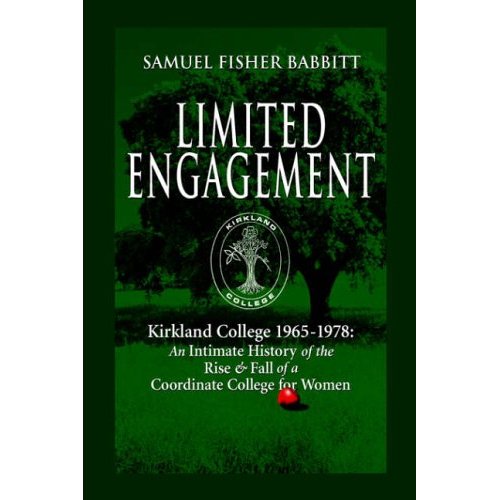 Below, a review of Samuel Babbitt’s Limited Engagement, a self-published history of the short but glorious life of Kirkland College, of which Babbitt was the founding and only president. Limited Engagement shows how self-publishing makes it possible to create great books that have a fundamentally limited audience. This review was originally posted on my site Wetmachine, part of a my very occasional series of reviews of self-published books.
Below, a review of Samuel Babbitt’s Limited Engagement, a self-published history of the short but glorious life of Kirkland College, of which Babbitt was the founding and only president. Limited Engagement shows how self-publishing makes it possible to create great books that have a fundamentally limited audience. This review was originally posted on my site Wetmachine, part of a my very occasional series of reviews of self-published books.
One night in the late spring of 1978, two young women broke into the registrar’s office at Hamilton College. Their mission was simple: to remove their academic records, along with all other evidence that they had every had anything to do with Hamilton. They were members of the last class to receive diplomas from Kirkland College, which was about to be swallowed whole by Hamilton, the college across the street. The Kirkland College board of trustees, with a figurative fiscal gun to their head held by the Hamilton board, had reluctantly, in a split decision, agreed to the merger. But the students never agreed, and as far as some of them were concerned, Hamilton had no more rights to their records than did the man in the moon.
Samuel Fisher Babbitt was Kirkland College’s first and only president. Recruited at age 36 from an assistant dean’s position at Yale Graduate School, he had already been Dean of Men at Vanderbilt University for four years and was working on a PhD in American Studies while doing his administrative job at Yale.
He accepted the presidency of Kirkland before the college existed. On the day he arrived to start work, his office was in some borrowed space on the Hamilton campus, and Kirkland had neither faculty, nor students, nor curriculum, nor buildings. What it had was some money, an apple orchard, a mission to create a women’s college to share the hilltop where the venerable Hamilton College had been educating men since 17901, a visionary board of directors, and lukewarm support from Hamilton itself. Under his leadership, Kirkland designed and built a modern campus, recruited a first rate faculty, raised significant amounts of money–some of it from unlikely sources, attracted and taught a remarkable cadre of adventurous young women, evolved and nurtured a unique and successful progressive educational philosophy, and permanently changed for the better the entire meaning of Hamilton College itself. Babbitt stayed on until Hamilton’s hostile takeover was complete and Kirkland College no longer existed as a legal entity.
Now he has published a comprehensive history:
Limited Engagement
Kirkland College 1965-1978:
An Intimate History of the
Rise and Fall of a
Coordinate College for Women
Xlibris.com ISBN: 1-4257-0069-1
Drawing upon his own private records, Hamilton and Kirkland College archives, oral histories from the Kirkland History project, diaries and letters of Kirkland alumnae and faculty, and other sources, he has produced a fascinating, comprehensive and exhaustively documented history, 536 pages long including index. The first sentence in the book, in the Acknowledgements, is “I started to write this book before Kirkland held its last graduation.” In other words, he worked on it for thirty years. It shows. It’s a great book.
Kirkland College’s short life had a beginning, a middle, and and end, and Limited Engagement lays them out in chronological order, each topic taking up about 1/3 of the book.
The beginning of the college came from two main impetuses: the first was the clearsighted vision of Hamilton College president Robert McEwen. By 1960, McEwen, an ordained Presbyterian minister, had been president of Hamilton for eleven years. Hamilton had long been a well regarded college of the east coast “establishment”. It had been producing future doctors, lawyers, ambassadors, educators, financiers, and the occasional Secretary of State for a long time. It had unimpeachable academic credentials, and its faculty and board were largely very self-satisfied and quite sure that the Hamilton Way was the right way to provide a liberal arts education. According to Babbitt, however,
“[McEwen] had intellectual honesty, and he had travelled enough outside the narrow confines of Clinton, New York to know that there was fundamental change abroad in the world of education, and that Hamilton was in danger of becoming a quaint anachronism.”
The second impetus for the creation of Kirkland came from the Ford Foundation, which in the mid 1960’s, “was engaged in an unparalled cash giveaway to liberal arts colleges and universities. The requirements of the Foundation’s grants set Hamilton College, like many other recipients, on the path of ‘long range planning,’ an activity virtually unheard of in the academic world before that time.”
In order to get their hands on a big chunk of Ford Foundation money, Hamilton duly undertook a long range planning process. What that process revealed was that unless Hamilton changed, it was going to have a harder and harder time attracting the highly qualified students it wanted, because Hamilton was too isolated, its course offerings were too limited, and, mainly, THERE WERE NO WOMEN. Times were changing, and qualified applicants were turning down at an increasing rate the opportunity to matriculate at Hamilton. The upshot was, Hamilton decided to create a new liberal arts college for women, leaving open the possibility of creating other “coordinate” colleges or graduate schools in the future. Because of McEwen’s influence (which was not counterbalanced by the inertial force of more traditional elements of the Hamilton community, who took no interest in it), Kirkland College (named for Hamilton’s founder Samuel Kirkland, missionary to the Oneida) was given a very explicit charge to take or leave as much of the Hamilton Way as it wanted, and to invent its own, new, Kirkland Way. Having gotten the ball irrevokably rolling, Robert McEwen died of a heart attack in the spring of 1966.
So, Kirkland College, from its inception, set out to invent its own, new, non-Hamilton way. Which it did. And how.
The middle part of the book describes how the Kirkland faculty, student body and administration, with the full support of a board of trustees led by a few old-school feminists near or past retirement age who had seemingly been waiting their whole lives for the chance, developed a learning community that was heavy on the arts, heavy on democratic participation in decisions affecting the school, adventurous and sometimes chaotic in self-governance, and which eschewed grades in favor of evaluations.
From the beginning, Hamilton courses were open to Kirkland students; Kirkland courses were open to Hamilton students; all dining halls were open to all students, and the Hamilton library became the Hamilton-Kirkland library. The campuses were literally across the street from each other.
The kind of young woman who would accept admission to a school that had never offered a course, that had no dormitories or classrooms, much less traditions or reputation, was necessarily more adventuresome than the typical high school student applying to college. And of course, this was the height of the sixties. The first cohort of Kirkland students arrived on campus in the fall of 1968, when the Viet Nam war was raging and Jimi, Dylan,the Airplane and the Beatles were the universal prophets. If the first-ever batch of Kirkland students to set foot on College Hill weren’t all peacenicks and hippies, there certainly was a strong countercultural influence among them. Not to mention the unmistakable sensibility of feminism, which was a new and, to some men, a threatening attitude. Many Hamilton (male, ipso facto) students, on the other hand, were third or even fourth-generation Hamiltonians–a fair number of whom were from Old Money–for whom a decision to attend Hamilton was about as daring as a decision to order red wine with beef. The faculties were similarly contrasting. And at first, Hamilton and Kirkland mixed about as well as oil and water.
When you look at the Hamilton, and then Hamilton-Kirkland college yearbooks from the period from 1970 to 1974, you see a remarkable evolution. In the 1970 Hamilton yearbook you see no Kirkland women; the seniors, who look somewhat uptight but not hopelessly square, are in posed pictures, some freestyle, some in silly frat-boy joke poses. In 1971, the style of photos is more relaxed, and women appear in them here and there. In 1972, the graduation year of Kirkland College’s “charter class” — the first students who had attended four consecutive years– for the first time the yearbook is a combined Hamilton/Kirkland book, and while there is some photographic evidence of a more square Hamilton feeling and a more hippie Kirkland feeling, it’s clear that a common culture is emerging. By 1974, Hamilton-Kirkland is one place.
Limited Engagement documents these heady times with minutes from tumultuous faculty and board meetings, tales of fundraising derring-do, stories of false steps and unexpected successes; of great teachers and of teachers who had to be fired. Ultimately it’s the story of the emergence of a particular Kirkland sensibility which was fun, feminist and ferociously serious about the idea of a liberal education. The tale of how, with a nudge from Babbitt, local businessman Edgar Virgil Johnson came to donate enough money for a scholarship fund and a classroom building is alone worth the price of the book.
When I arrived as a freshman at Hamilton College in the fall of 1970, Kirkland College was a very new thing. Its buildings were still under construction, and some Hamilton upperclassmen regarded Kirkland women as unwanted, unmerritorious intruders. At a hall meeting in the freshman dorm, our R.A. told us that Kirkland women were to be avoided: they were feminists who hated men, we were told; they didn’t shave their legs, their politics were suspect and they weren’t pretty. He informed us that by tradition from time immemorial, Hamilton men dated women from high-class joints like Skidmore Collge, more than two hours away. When Hamilton men wanted to meet women, we were told, they went on “rolls”. Which. . . well, you can imagine.
(John Nichols’s book The Sterile Cuckoo from which was made the movie that launched Liza Minelli’s career documents this pre-Kirkland Hamilton very well.)
It didn’t take me or my classmates long to figure out that that was a lot of nonsense. I won’t bore you with reminiscences of my college days, but suffice it to say that although my diploma says Hamilton College, 1974, Kirkland College was every bit as much a part of my four undergraduate years as Hamilton was.
The final part of Babbitt’s book deals with the circumstances of the financial crunch that eventually brought about the demise of Kirkland and its merger into the thereafter coeducational Hamilton. Although the financial problems were real, Babbitt convincingly argues that there were strategies available which could have allowed Kirkland to survive, and that it was bad faith on the part of the Hamilton Board of Trustees, and in particular of Hamilton president Martin Carovano, that doomed Kirkland to an early death. I myself always thought Carovano was a prick, and although Babbitt is much too gentlemanly to say any such thing, it’s clear what he thought of the highhanded way Kirkland was treated at the end by its blueblood sibling.
It’s eye opening to read the remarks written by Frank Bate (a Hamilton Alumnus on the Kirkland board (whose daughter Adriana, Kirkland ’74, had been a friend of mine since high school)), and delivered in a meeting with the Hamilton board. It’s clear that in Bate’s eyes Hamilton was calling in its marks from Kirkland exactly as a mafioso would call in its marks and confiscate home & business from a slow-paying client of a loan shark. To say there was anger around campus at that time is to considerably understate the depth of feelings at play.
I’m that rare kind of Hamilton grad who has never managed to gain any financial security, so my boycott of Hamilton alumni fundraising for the first ten years after my graduation didn’t set the college back. But I was not alone in my boycott. Anger among Hamilton alumni about the way Kirkland was summarily gobbled up caused the college to miss its projected contributions by twelve million dollars over the next ten years, a sum nearly identical to the thirteen million Hamilton saved by killing Kirkland as an independent entity. From 1978 to about 1985, if anybody from Hamilton called me to seek a contribution, I hung up on them.
Sometime in the 1980’s I decided it was time to chill out, and I decided to go to a Hamilton recruiting event being hosted by President Carovano at the Ritz Carlton in Boston. I found Carovano’s talk depressing, and the promotional film he showed even more depressing.
In the mingling afterwards, I said to him, “The Hamilton I went to was a place of unending intellectual challenge, a constant pulling of the legs out from under me, a place to radically grow up and where professors called bullshit on their students. What you seem to be offering is a safe place for the pampered elite to send their precious babes to be pampered and spoon fed.”
He replied, essentially, “you’re right.”
So I said, “Why the hell is that? It’s a betrayal of everything Hamilton stands for.”
And he said something to the effect of, “Because that’s where the money is.”
And there’s something to be said for that point of view too, I guess, for Hamilton is a spectacularly endowed college. Check out their website. Take a visit. I’m not kidding. The place has everything you would find at a top university, and there are only a few thousand students there. From music halls to libraries to athletic facilities to science labortories, everything is top-of-the-line.
When it was time for my older daughter to look at colleges, I talked her into looking at Hamilton. She was a top student and artist and student activist in high school; she had founded the local chapter of Amnesty International and a rock-and-roll artists’ collective and a shelter for battered women. Her classmates had voted her “most unique”. I didn’t think Hamilton would be a good match for her, but its facilities are so outstanding that any bright kid should at least consider applying there. So we went to take a look. There’s a new student center there now, halfway between the Hamilton and Kirkland campuses. I found it depressingly fake, like a little bit of Disney’s Main Street USA. There is a brick pathway that leads from the student center to the Kirkland campus. It’s called “Martin’s Way” after Martin Carovano. Now, ain’t that a stick in in the eye.
After her interview and tour my daughter said to me, “Dad, I can’t go here.”
“Why not?” I said.
“I don’t want to be ‘most unique’ anymore.”
We stopped in to see my favorite professor from twenty-five years earlier, who was now two years from retirement. After chatting with us for half an hour, he said to my daughter, “Don’t apply here. They don’t want people like you and your father anymore.” It was extremely sad to hear him say that. Of course, I’m an old fart, my professor is an even older fart, and all old farts think things were better back in their day, so you should dismiss what I just said, because it’s got precious little to do with Babbitt’s book.
Babbitt’s book represents self-publishing at its best. The market for this book is necessarily small, and I can imagine that if small university press had published it, Babbitt would have been pressured to make it shorter in the interest of keeping costs down. By publishing it himself, Babbitt wisely retained control over all that. Limited Engagement is well written, exhaustive, meticulously documented, handsomely laid out, and well manufactured. I did spot a few typos and an amusing error in the index, but as a Hamiltonian, I give it an A+. If you have any interest in Kirkland College or how the Hamilton College of today came to be what it is–or in liberal arts colleges in general– you should pick up a copy.
One of the two women who broke into the Hamilton registrar’s office in spring, 1978 was my sister Margaret, Kirkland ’78. As it turned out, she decided to leave her records there after reading them, although her companion did remove hers. Among the records Margaret found were the notes from the admissions committee who had interviewed her four years earlier. The two Kirkland representatives had given her the big thumbs up. The Hamiltonian on the committee had given her the thumbs down.
Twenty-some years later, Margaret too found herself back on campus when a niece was looking at colleges. My sister asked her tour guide, a young woman who was a Hamilton sophomore, about her alma mater.
“So tell me,” my sister said. “Is there any of that old Kirkland spirit left here?”
“Kirkland? What’s that?”
Many Kirkland alumnae have made their peace with Hamilton. They write into the alumni magazine, they serve on committees, they donate money to Hamilton. I suppose if I ever get any money, I’ll give some too. (You can help! Buy one of my books!)
In the end, at great cost to itself, Kirkland did exactly what President McEwen had wanted it to do, which is that it saved Hamilton from itself. According to Dwight Lindley, a long time professor at Hamilton (from whom I took a course in 19th century poetry), in the years before Kirkland was dreamed of, McEwen had floated the idea of making Hamilton coeducational. The resistance was so strong and vituperative among faculty and alumni that he had to give up.
This year, as in every year since 1978, about half of Hamilton’s graduates will be women.
1: What Babbitt calls the “academic community on the hilltop that Hamilton had occupied in distinguished isolation for over a century and a half”
Get an Editorial Review | Get Amazon Sales & Reviews | Get Edited | Publish Your Book | Enter the SPR Book Awards | Other Marketing Services


















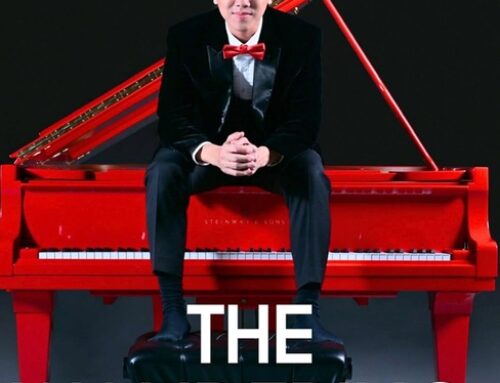
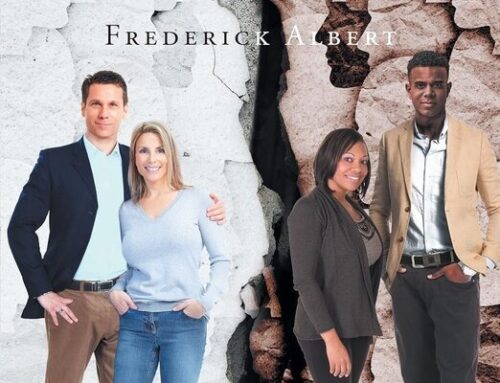
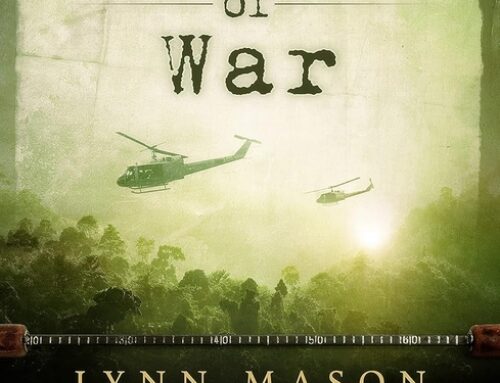
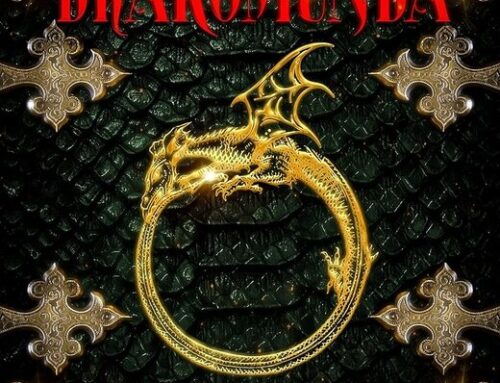
Leave A Comment